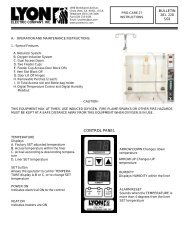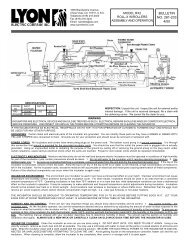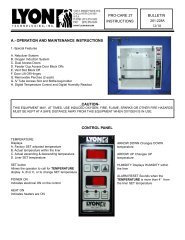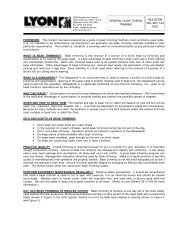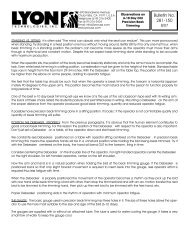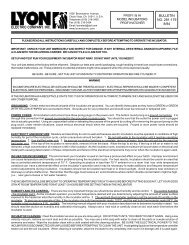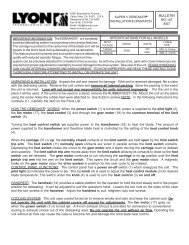a general guide to beak trimming game birds and duck debilling - Lyon
a general guide to beak trimming game birds and duck debilling - Lyon
a general guide to beak trimming game birds and duck debilling - Lyon
You also want an ePaper? Increase the reach of your titles
YUMPU automatically turns print PDFs into web optimized ePapers that Google loves.
Bulletin 281-145 Page Four<br />
PHEASANT PRECISION BLOCK DEBEAKING:<br />
(CONTINUED) While this method is unproven at this<br />
time, if successful, it would be a one time permanent<br />
<strong>beak</strong> trim such as on layer chickens. The savings in<br />
less stress <strong>and</strong> labor costs for additional <strong>beak</strong><br />
<strong>trimming</strong> would be significant. For full information on<br />
6-10 Precision Block De<strong>beak</strong>ing of layer chicks, send<br />
for our Bulletin number: 281-119.<br />
DUCK DEBILLING: Feather pulling causing loss of pin<br />
feathers, bloody wing tips <strong>and</strong> scratched backs are a<br />
problem in raising <strong>duck</strong>s. Proper bill <strong>trimming</strong> can<br />
overcome this. Two types of <strong>debilling</strong> are used <strong>and</strong><br />
both are summarized below.<br />
DAY-OLD DEBILLING: The BHT Attachment (Catalog<br />
Number 940-006) is used on the De<strong>beak</strong>er® for this<br />
method of <strong>debilling</strong>. The height adjustment screws on<br />
the attachment are adjusted <strong>to</strong> allow the <strong>duck</strong>'s upper<br />
<strong>and</strong> lower bill <strong>to</strong> be placed on the <strong>beak</strong> support tube.<br />
The heat of the blade is adjusted <strong>to</strong> a dull red color (in a<br />
subdued light). The upper <strong>and</strong> lower bill are not allowed<br />
<strong>to</strong> separate. Slight pressure under the lower <strong>beak</strong> using<br />
the forefinger may be necessary. The closed bill is placed<br />
on the <strong>beak</strong> support <strong>and</strong> moved forward in<strong>to</strong> contact with<br />
the blade. The area seared is on the UPPER BEAK ONLY<br />
<strong>and</strong> includes the nail or bean <strong>and</strong> extends <strong>to</strong> the tip of<br />
the upper bill. If trouble is experienced in clean removal<br />
of the nail, tilt the head down slightly <strong>to</strong> finish the<br />
operation. While high rates of production are possible<br />
using this method, close attention <strong>to</strong> a proper searing of<br />
the upper bill area is necessary. Failure <strong>to</strong> properly sear<br />
<strong>and</strong> remove the nail completely will defeat the purpose<br />
<strong>and</strong> negate the higher rates of production advantage.<br />
DEBILLING AT 3 DAYS OF AGE: Debilling at 3 days is<br />
done using a cutting blade on the De<strong>beak</strong>er®. The<br />
De<strong>beak</strong>er® may be foot pedal operated or operated by<br />
a Pow-R-Pak Power Unit using a “Hen” cam. When <strong>duck</strong>s<br />
are debilled at 3 days of age they are slightly debilled<br />
with only 1/2 of the upper nail being removed. Bill<br />
regrowth will usually reoccur using this method.<br />
DEBILLING AT 7 DAYS OF AGE: Tests in past years<br />
tend <strong>to</strong> prove that severe <strong>debilling</strong> at 7 days of age is<br />
the most effective way <strong>to</strong> reduce feather pulling,<br />
scratching, etc. The De<strong>beak</strong>er® uses a cutting type<br />
blade <strong>and</strong> may be foot or power unit operated as in 3<br />
day old <strong>debilling</strong>. The cut is made about 3/4 of the way<br />
back on the nail as shown in the illustration. Ducks<br />
debilled in this manner will rarely have the bill grow back<br />
completely in less than 7 weeks.




